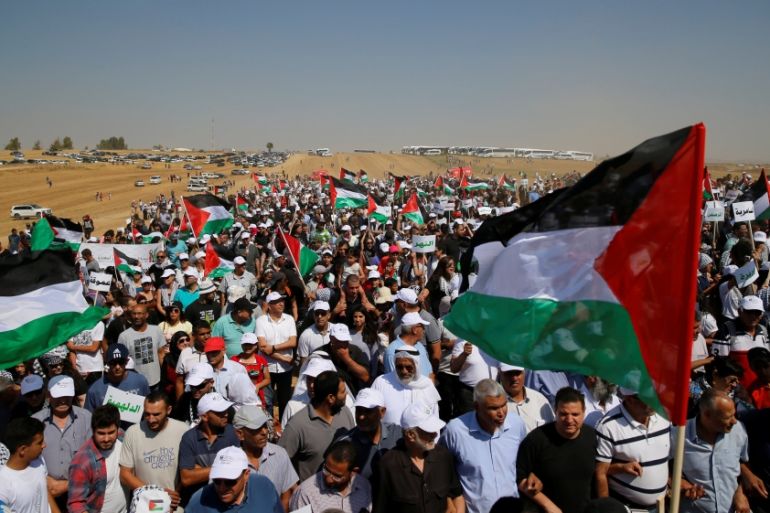Nakba Day: A ‘clear challenge’ to Israeli establishment
While the Nakba Law threatens publicly-funded institutions, there are signs of optimism at the grassroots level.

Last week, as Israelis celebrated their Independence Day, Palestinians in the country’s south held the annual March of Return, walking to the site of one of hundreds of Palestinian villages destroyed between 1947 and 1949.
This mass displacement and dispossession, known as the Nakba (catastrophe), is commemorated internationally each May. But in recent years, Israeli authorities have attempted to clamp down on events to mark the Nakba – most notably through a 2011 change to legislation pertaining to budget allocations.
Keep reading
list of 4 itemsPalestine: Banned in Berlin
Determined Palestinian youth pledge to fight for liberation
Palestine’s Abbas calls on UN to ‘suspend’ Israel as Nakba marked
What became known as the Nakba Law introduced a new condition to the criteria for eligibility for state funding, stipulating that funding could be denied if the body in question – such as a Palestinian municipality – marked Israel’s Independence Day as a day of mourning.
READ MORE: Palestinian Bedouins ‘live the Nakba every day’
In 2012, Israel’s Supreme Court rejected a petition against the Nakba Law, saying that it was too early to assess the impact of the legislation.
“The law is very vague, and does not set clear definitions, including for what constitutes ‘mourning’,”
|
|
said Sawsan Zaher, a lawyer at Adalah, the legal centre for Arab minority rights, who litigated the unsuccessful petition. The ambiguity of the criteria “creates a huge chilling effect”, with local councils choosing not to sponsor Nakba events so as to avoid the risk of sanctions, Zaher told Al Jazeera.
The Nakba Law is not the only example of recent efforts by the Israeli government to legislate against political activism. The Anti-Boycott Law, passed by the Knesset in 2011 and upheld almost in its entirety by the Supreme Court in 2015, allows for civil lawsuits against those calling for boycotts, including of West Bank settlement products.
Culture Minister Miri Regev, meanwhile, has made clear her wish to deny funding to those deemed “disloyal“ to the state. Last week, she declared a new initiative to force state-funded sporting and cultural institutions to fly the Israeli flag. To Zaher, such moves send “a very dangerous political message”.
Meanwhile, this year marked the first time that the March of Return took place in the Negev/Naqab, a decision heavy with political significance. The specific village where it occurred, Wadi Zubala, was destroyed in 1948 and its land given to kibbutzim. Its residents were ultimately forcibly displaced by the Israeli military to Umm al-Hiran – a village that is now also under threat, with the state planning to destroy it and establish a Jewish community in its place.
The “nucleus” of future residents for the new town comes from Eli, a West Bank settlement. According to an Israeli government website, the goal of their relocation is to “build a faithful community dedicated to …contributing meaningfully to the demographic balance, out of a Zionist vision of settlement”.

Holding this year’s March of Return in the Naqab “links it with the ongoing Nakba, a process of displacement that continues to this day”, said Nadim Nashif, the director of Baladna, a youth organisation and one of the groups that supported the march.
“The Naqab is the main area that suffers from home demolitions and oppression on a daily basis,” Nashif told Al Jazeera. The region is also a focal point for efforts to resist, such as the 2013 campaign to stop a government plan to expel tens of thousands of Bedouin Palestinian citizens.
The annual march is organised by the the Association for the Defence of the Rights of the Internally Displaced in Israel, which was founded in 1995 and represents an estimated 300,000 internally displaced Palestinian citizens of Israel.
The march has garnered support from a number of other political groups and NGOs, including Zochrot, an organisation whose work is focused on educating the Jewish Israeli public about the Nakba, and the Palestinian refugees’ right of return.
READ MORE: Israel continues to criminalise marking Nakba Day
|
|
If the size and strength of the annual march is anything to go by – last week’s march drew several thousand attendees – efforts by the Israeli government to intimidate Palestinian citizens have been effective. But according to Nashif, there has been an increase in recent years in Nakba-focused activism all year round – especially by the younger generation.
In Kafr Birim, a village ethnically cleansed during the Nakba, former residents have set up camp, renovating the local church and holding various community events. In al-Ghabisiyya, as in other villages, young Palestinians have been returning, holding summer camps and discussing what it would look to rebuild their community.
Thus, while the Nakba Law remains a threat to publicly funded institutions, there are signs of optimism at the grassroots level.
“The quantity of activities that are held annually, and participated in by thousands, reflects a more general growth in Palestinian patriotism and consciousness,” said Maria Zahran, a political activist and online fundraising techmaker at Adalah.
“It is a clear challenge to an Israeli establishment that seeks to restrict our political rights and freedom of speech.”